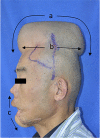Pre-expanded bipedicled visor flap: an ideal option for the reconstruction of upper and lower lip defects postburn in Asian males
- PMID: 32341918
- PMCID: PMC7175765
- DOI: 10.1093/burnst/tkaa005
Pre-expanded bipedicled visor flap: an ideal option for the reconstruction of upper and lower lip defects postburn in Asian males
Abstract
Background: Reconstruction of upper and lower lip subunits is a complicated and elusive challenge. For patients affected by defects involving upper and lower lip subunits, a technique able to reconstruct both aesthetic units with matched colour, sufficient contours and similar texture would be ideal. In this study, we present our experience with upper and lower lip reconstruction using the pre-expanded bipedicled visor flap.
Methods: From January 2014 to January 2017, 12 male patients presenting with defects of the upper and lower lip subunits were treated using this surgical technique. After a period of expansion of the scalp flap of over 6 months, the bipedicled visor flap was raised from both the parietal regions and rotated to resurface the defect. Delay and section of the pedicle were then performed.
Results: Twelve male patients with postburn scars aged 22 to 48 years (mean: 34 years) were successfully treated with no major complications. The donor site was closed primarily in all cases. Subsequent flap debulking and minor revisions were performed under local anaesthesia between 6 and 12 months postoperatively.
Conclusions: The pre-expanded bipedicled visor flap provides an effective and reliable option for upper and lower lip reconstruction with excellent colour and texture. It is feasible to achieve these results simultaneously from a single donor site by using a pre-expanded bipedicled visor flap.
Keywords: Lip defect; Postburn; Pre-expanded; Reconstruction; Visor flap.
© The Author(s) 2020. Published by Oxford University Press. All rights reserved.
Figures




References
-
- Guo L, Pribaz J. Preexpanded ultra-thin supraclavicular flaps for (full-) face reconstruction with reduced donor-site morbidity and without the need for microsurgery (discussion). Plast Reconstr Surg. 2005;115:1845–7. - PubMed
-
- Rose EH. Aesthetic restoration of the severely disfigured face in burn victims: A comprehensive strategy. Plast Reconstr Surg. 1995;96:1573–85. - PubMed
-
- Pallua N, Machens HG, Rennekampff O, Becker M, Berger A. The fasciocutaneous supraclavicular artery island flap for releasing postburn mentosternal contractures. Plast Reconstr Surg. 1997;99:1878–84. - PubMed
-
- MacLennan SE, Corcoran JF, Neale HW. Tissue expansion in head and neck burn reconstruction. Clin Plast Surg. 2000;27:121–32. - PubMed
-
- Vinh VQ, Ogawa R, Van Anh T, Hyakusoku H. Reconstruction of neck scar contractures using supraclavicular flaps: Retrospective study of 30 cases. Plast Reconstr Surg. 2007;119:130–5. - PubMed
LinkOut - more resources
Full Text Sources

